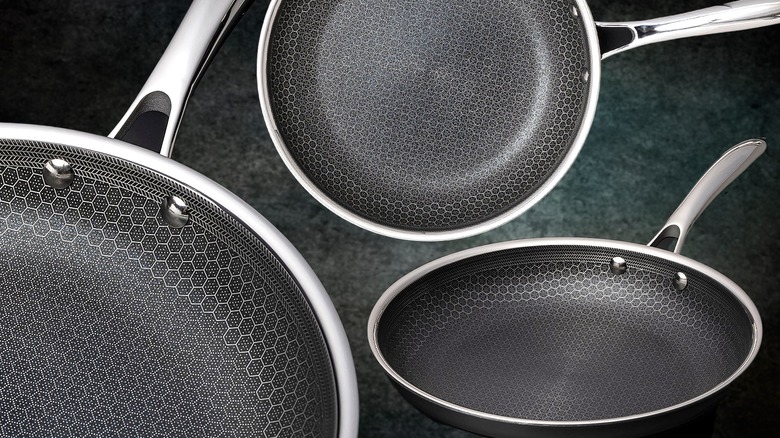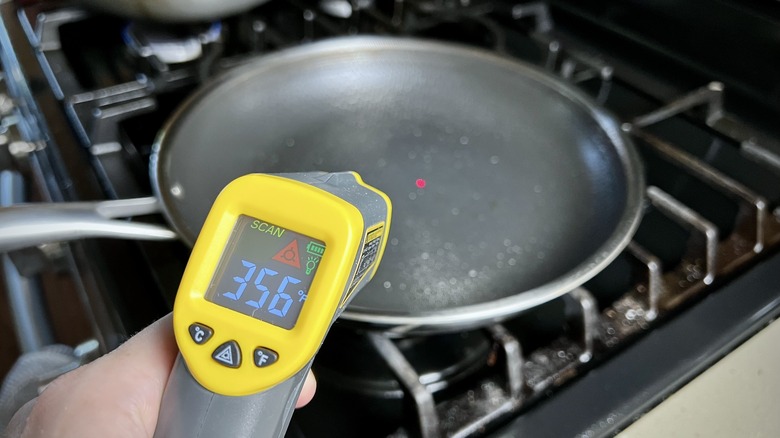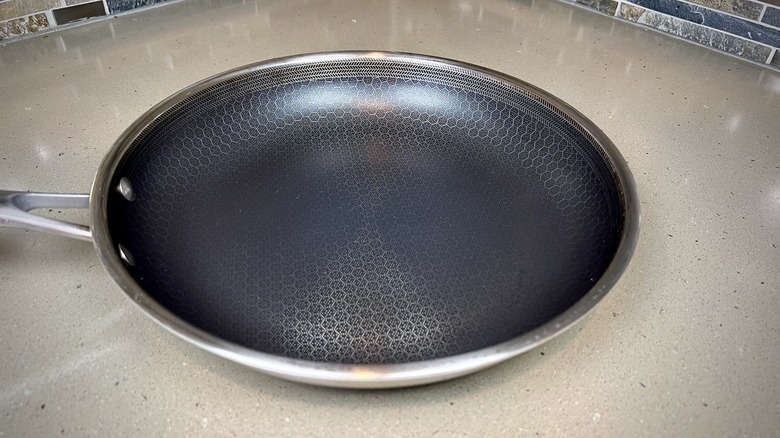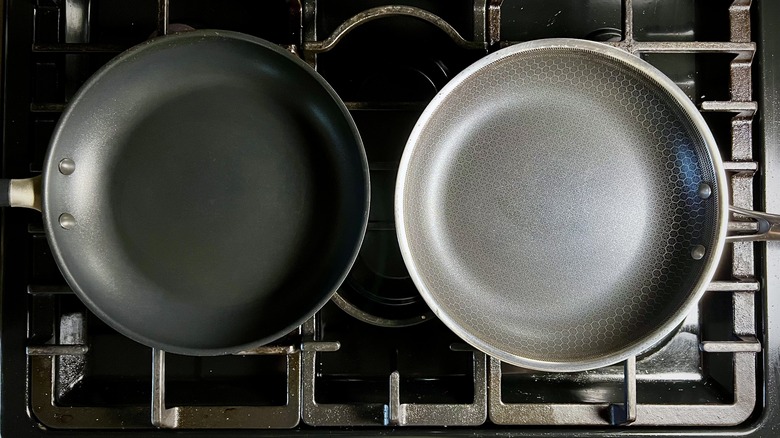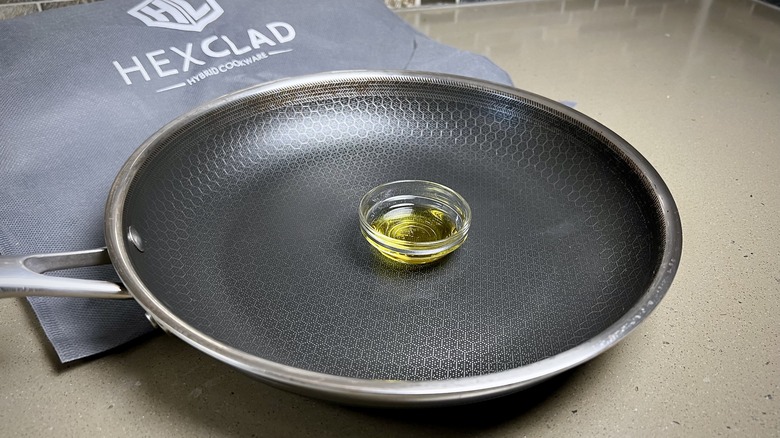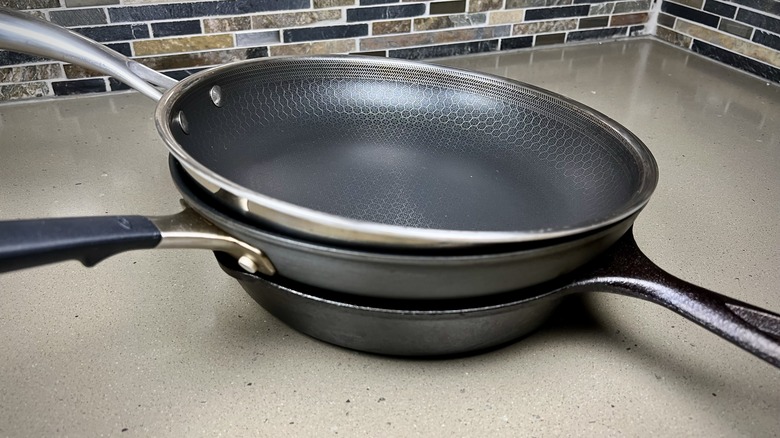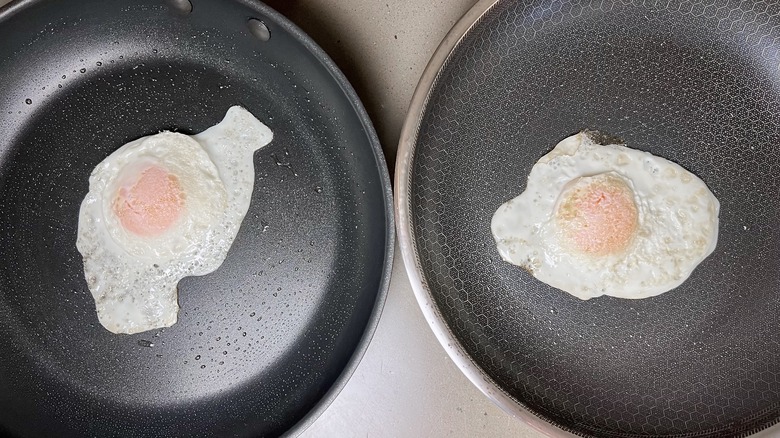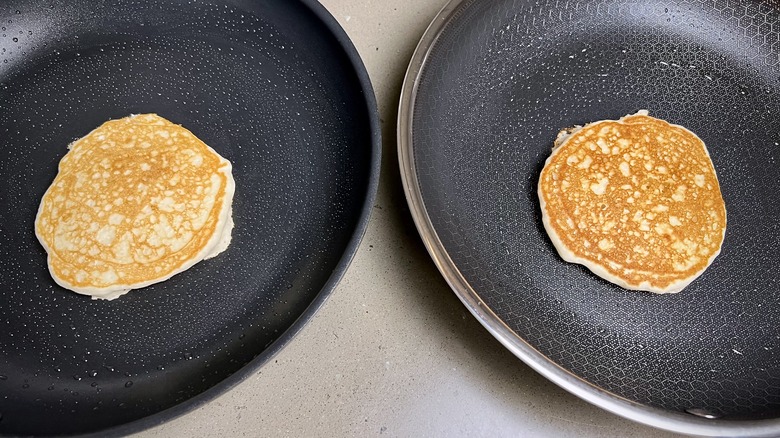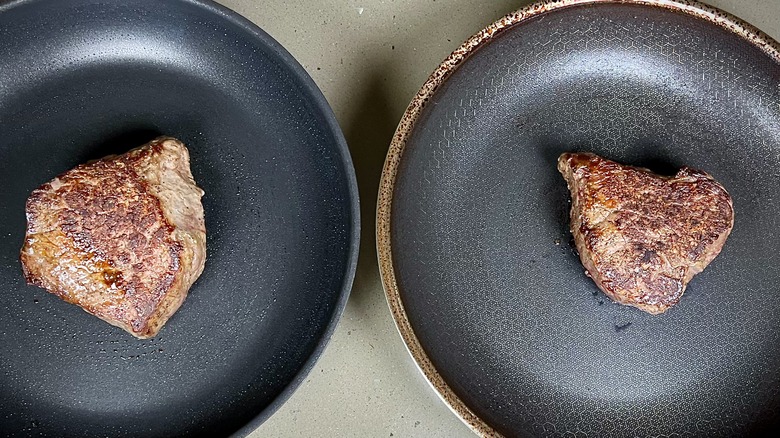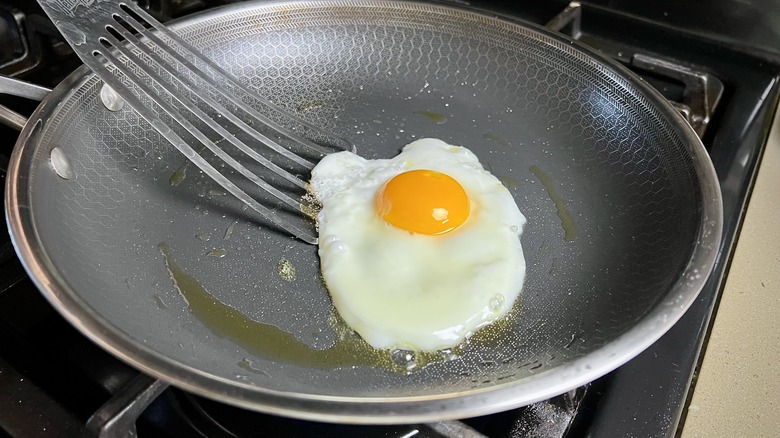Review: HexClad Pans Don't Come Cheap, But They're Well Worth It
Whether you're a beginner or cooking on a professional level, anyone that's part of the culinary world needs a sturdy set of pots and pans. Unfortunately, it's difficult to know where to start. There are so many options on the market today, from the various available materials to all the different aesthetic design choices. Luckily, all-in-one pans exist to help navigate the waters, preventing you from going too far down the research rabbit hole.
HexClad made waves when it launched in 2017 and quickly earned notable fans such as Gordon Ramsay and Oprah Winfrey. Its signature hybrid pan boasts the durability of a stainless steel pan and the promise of a non-stick surface that works as well as Teflon or ceramic pans. So we picked up a 10-inch HexClad Hybrid Pan and put it to the test. After cooking over-easy eggs, flipping pancakes, searing steak, and measuring the pan's surface temperature with an infrared thermometer, we can confidently say whether this pan is worth its price tag.
What makes HexClad's hybrid pans different?
The first thing that makes a HexClad pan stand out is its unique hexagonal design. Most pans have a smooth, single-colored coating, but the HexClad's black surface is studded with a laser-etched stainless steel hexagon pattern. This isn't just for looks; the etching is how the pan achieves its searing power while still being nonstick. HexClad uses patented technology that's based on a "high-grade, non-toxic Japanese coating," and the company claims that the shiny steel peaks that stud the pan's surface provide durability and even heat distribution. If you hold it up to the light, it lightly shines and shimmers — that's because it's infused with diamond dust. Put it all together, and it means you can use metal utensils on this nonstick coating without scratching the surface, which is not the case when using ceramic or Teflon-coated nonstick pans.
The pan is also designed to sear at low temperatures, something we have never heard of doing with other cookware brands. HexClad constructs its hybrid pans with three layers: a layer of magnetic stainless steel (making the pan work for induction cooktops), an aluminum core (to conduct heat quickly), and a non-reactive, durable stainless steel finish. This combination is intended to distribute heat more evenly over the cooking surface and heat the pan quickly, allowing you to get that desirable sear without cranking up the dial on your stovetop.
How to buy HexClad hybrid pans
HexClad hybrid pans are primarily available from the company's website. There are three sizes of the hybrid pan — an 8-inch pan for $139.99, a 10-inch pan for $179.99, and a 12-inch pan for $199.99. These pans don't come with a lid, something you'll need if you plan to steam vegetables or keep spattering oil in check while cooking. The HexClad tempered glass lid has a stay-cool handle and a steam vent, and each costs an extra $20, $25, or $30, respective of the pan sizes. Cookware bundles can save you a lot of money: A collection of all three hybrid pans (including the lids) costs $399.99. If you plan to replace your entire cookware set, HexClad also makes other hybrid cookware, including saucepots, a griddle pan, a wok, or a Dutch oven.
We have also seen HexClad cookware for sale online from Walmart, Bed Bath & Beyond, and Amazon. If you plan to make your purchase from an outside retailer, do your homework. HexClad's lifetime warranty only covers new products purchased from authorized sellers within the United States.
These pans don't come cheap
Compared to other nonstick pans, HexClad pans are expensive: Our OXO 10-inch nonstick pan costs $25 on Amazon. However, that's not exactly a fair assessment, as a hybrid is designed to do more than the standard nonstick pan. While a traditional nonstick surface degrades over time, HexClad's hexagonal pattern protects the nonstick coating from scratches. It's also designed to withstand high heat, and the hybrid pan is oven-safe to up to 500 degrees Fahrenheit. When compared to other tri-ply stainless steel pans that can do the same thing, the price doesn't seem as outrageous.
Considering the relatively high cost, purchasing a pan like this could be considered as a long-term investment. It does, however, come with a lifetime warranty, so the purchase will be well worth it if you take proper care of your cookware. Just keep in mind that the warranty does not cover damage due to improper use, so you'll want to take care not to expose it to excessive heat or improper storage. The warranty also doesn't apply to improper cleaning or lack of seasoning, so make sure you follow the initial seasoning process.
HexClad pans need to be seasoned before first use
Some pans — like cast iron and carbon steel — require a seasoning layer to make the surface nonstick. It's always best when the pan comes pre-seasoned because the initial process can be a bit of a pain. We have spent close to an hour seasoning a brand-new carbon steel wok, and the smell is horrible!
While the HexClad pan does need to be seasoned to finalize the nonstick layer, the process was pretty painless. Simply heat the pan over medium-low heat and add a teaspoon of oil (vegetable, avocado, or olive oil are the recommended options). Spread the oil over the inside of the pan and let it sit on the burner for two to four minutes. The heat is low enough to prevent the pan from smoking (our major gripe with seasoning carbon steel), and it's a one-step process. When the timer goes off, let the pan cool down, wipe out the oil, and wash the pan with warm, soapy water.
If you take advantage of the pan regularly and use cooking fats, it will continuously season itself. In the event that the pan's surface loses its nonstick abilities over time, HexClad recommends giving it a deep clean with an abrasive sponge. Then, repeat the seasoning process.
How the HexClad hybrid stacks up against another types of pans
We aimed to find out if the HexClad hybrid could handle the work of other popular cookware, like cast iron, nonstick, and stainless steel pans. Remember that HexClad's hybrid pan is built with a tri-ply construction (two layers of stainless steel sandwiched around an aluminum layer). That makes it a perfect replacement for other stainless steel pans, with the added bonus that it has a nonstick layer.
We found that the HexClad is more durable than most ceramic and Teflon-coated nonstick pans. Those options might be nonstick when you first buy them, but their delicate coatings break down over time. We have had a HexClad pan for several years now, and it is still as nonstick as when we first purchased it (in the same time period, we purchased two OXO pans).
Finally, we come to cast-iron pans. These are some of the toughest pans on the market, and our experience with them has shown you can put them directly into a fire pit and they will come out without a scratch. That said, the seasoning requires maintenance and special care to keep the surface nonstick, and they are extremely heavy. The HexClad pan seems to work almost as well here — unlike a cast iron, you can't put it directly on hot coals, but you can use it in the oven up to 500 degrees Fahrenheit. The seasoning layer doesn't require any special care, either. In fact, the pan is dishwasher-safe.
HexClad vs. traditional nonstick pan: The fried egg test
Once we seasoned the pan, we were ready to begin our tests. We put the 10-inch HexClad hybrid pan up against a 10-inch OXO nonstick pan with Teflon coating. Eggs are the ultimate test to analyze a pan's nonstick abilities, so we decide to do a side-by-side over-easy comparison. We put a teaspoon of oil in each pan, let the pan preheat over medium heat, and cracked the eggs. Once the whites set, we flipped the eggs and finished cooking them for one minute before flipping them back over to the original side.
The first thing we noticed is that the HexClad pan heated up faster than the Teflon pan. In our experience, nonstick pans heat more quickly than stainless steel pans, so we were surprised when the hybrid reached 300 degrees Fahrenheit a full 30 seconds before the OXO. When it came to performance, they both had admirable nonstick surfaces, and the eggs flipped without incident. Since the HexClad conducted heat so efficiently, the eggs cooked in that pan turned out a little browner due to the higher temperature, and they were slightly textured compared to the traditional nonstick eggs. The raised hexagonal pattern isn't flat like a Teflon pan, so it created a texture on the egg. Would we have noticed it if we weren't looking for differences? Probably not, but it was worth noting.
HexClad vs. traditional nonstick pan: The pancake test
The next test was to make a batch of pancakes. We wanted to see how the pans compared in evenness of heating, and a pancake is a perfect vessel to evaluate that. Pans that heat evenly display a consistent browning over the surface and those that don't create patchy caramelized bites.
After preheating the pans' surfaces to 375 degrees Fahrenheit (as measured with an infrared thermometer), we brushed each one lightly with oil and dropped 1/4 cup of pancake batter into the pan. After 90 seconds, we expected to see the surface bubble, indicating the pancake is ready to flip. The HexClad was ready at 85 seconds, and the OXO followed suit shortly after at the 90-second mark. We were pleased to see that neither pancake stuck, but one was slightly more even than the other.
It's worth noting here that the OXO is an excellent pan, and we were pretty thrilled with the pancake's appearance and texture. But the Hexclad's was just a little bit better with a more appealing, deeper brown color while still being nice and soft in the middle. It displayed a slightly more impressive heating pattern, too, browning over the entire bottom surface while the nonstick pan had a small patch that didn't get any color.
HexClad vs. traditional nonstick pan: The steak test
Our final test was designed to determine how well the pans could sear a steak. Our first test compared the pans at high heat, preheating the cooking surface to 400 degrees Fahrenheit. For round two, we cooked a steak at 300 degrees Fahrenheit to see how well the HexClad performed on its claim to sear at lower temperatures.
We were surprised that the OXO was capable of producing a generous sear on the steak, browning it fairly evenly from end to end (but missing a small patch in the bottom corner). These coated pans are really not designed to heat this high, though, and we wondered if we had done any damage to the pan in the process. It smoked and smelled terrible, although the steak tasted just fine.
The HexClad pan produced a gorgeous, even sear from end to end at both cooking temperatures. At the higher temperature, the edges of the stainless steel pan became discolored as the cooking fats adhered to the pan's surface. Luckily, these stains came off with a good scrubbing with the abrasive end of the sponge. The low-temperature steak had the same Maillard-reaction finish, displaying an evenly caramelized crust on the exterior. This steak got our seal of approval because it was juicier than the other two, even though all three were cooked to the same medium-rare level of doneness.
Verdict: HexClad exceeded our expectations
After putting the HexClad hybrid pan to the test, we were pretty impressed with the results. This pan truly fuses the benefits of quick-heating aluminum, the strength of stainless steel, and a fully-functional nonstick coating, all in an attractive package. Considering its effectiveness and versatility, we feel pretty confident this single pan can replace several pieces of cookware in our kitchen. The initial cost may be higher compared to most nonstick pans, but it brings a ton of value: sear, sauté, stir-fry, or start a dish on the stovetop and finish it in the oven.
Our only hesitation is that the pan does require a small amount of oil to be truly nonstick. When we tried to fry an egg with zero oil, it definitely stuck to the pan (which was not the case with Teflon). So if fat-free cooking is a priority, you might want to hold on to your nonstick pan for these specific instances.
